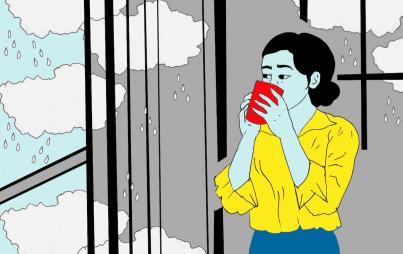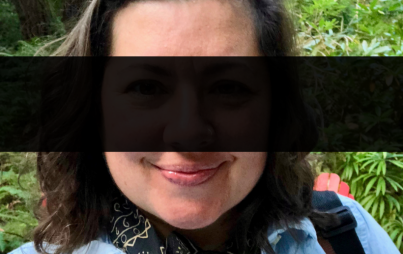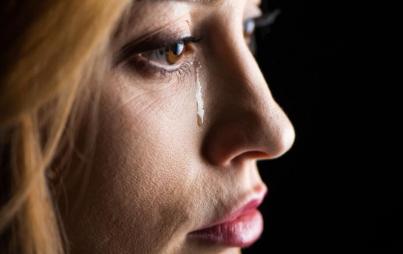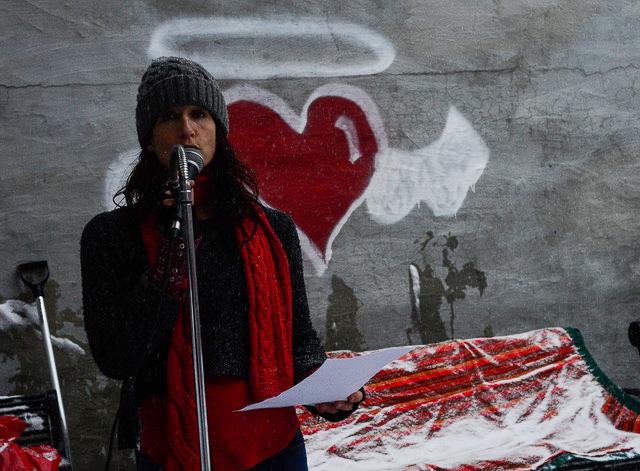
Diana Whitney at a #MeToo March on International Women's Day (Photo Credit: Kristopher Radder/ The Reformer)
CN: rape, sexual assault
I was lying in a backbend in the steamed-up yoga studio when the teacher stood on me. Reclining hero (supta virasana) is a vulnerable position: first, you kneel, then sit your buttocks on the floor between your feet, then gingerly recline backward. The teacher walked over and stood on my thighs, his full weight compressing my pelvis. I braced against the pressure — he was over six feet tall, close to 200 pounds. Completely immobilized, I felt no pain yet, only tension in my low back. After he stepped off, he walked around and briskly pulled my arms above my head: “being put on the rack,” the adjustment is called. I had craved the intensity of this class, had trusted his experience and authority, but I knew that something was wrong.
He had to peel my body up off the floor. A dull twinge in my sacrum later flared into chronic pain.
On the pastel walls of the studio were listed the limbs of yoga, among them ahimsa or “non-harming” and brahmacharya, often translated as “chastity” but also meaning “moderation.”
Many breaches of trust occur under the veil of “spirituality,” and those who try to lift the veil face dire consequences. Like many women who’ve been violated, yoga students keep silent for fear of not being believed — but there is a complicating layer — the fear of being ostracized or vilified by their yoga community.
A year later, I confronted the teacher about my sprained sacrum. He did not apologize or admit responsibility but told me I had been doing backbends improperly. He said mine had been an injury waiting to happen and I did not argue with him then, given my history of pelvic trauma, including two emergency c-sections. Although I was an experienced yoga teacher myself, I automatically deferred to his power and judgment. The man was an accomplished guru-type who’d owned an urban studio before opening shop in our small town. He had a devoted local following, mostly women like me who sought the addictive intensity of his classes— long, challenging vinyasa sequences followed by endorphin-drenched release.
Why did I feel shocked when he hurt me? I had known of other damage caused by his aggressive “assists.” One of my own students had suffered a severe hip injury when he forced her into a double-pigeon pose. She had taken legal action and eventually won a settlement in 2006, and I’d been asked to testify if necessary. I was also aware of disturbing sexual misconduct at his studio. I’d heard women say he wore running shorts without underwear, exposing his genitals while he stood over them. He lavished attention on young, pretty students: he had repeatedly offered private massage to one of my friends, then accused her of stealing from the donation bowl when she declined his “healing” advances.
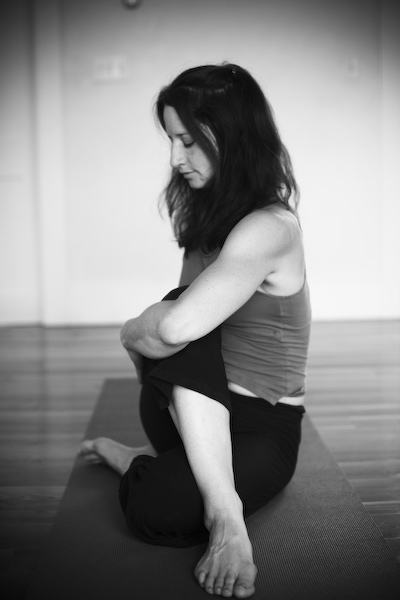
Still, I went back to his class. The yoga was powerful medicine, and the practice often felt like a communal purification ritual, the studio packed with female teachers, body-workers, and circus acrobats, all breathing together as he led us through the postures. The man was a skilled instructor. It took me three years to stop going and even then I remained silent. It was only after I learned he had fondled several women’s breasts during savasana (corpse pose) that I spoke out publicly.
There is a long history of male yoga teachers using their spiritual power to dominate and abuse women.
Amrit Desai, the founder of Kripalu Center and beloved guru to over 350 disciples, solicited sex from his female students while openly teaching celibacy. The guru’s sexual manipulations were concealed at the ashram during the 1980s until several victims were brave enough to speak up.
My father brought me to Kripalu in 1990 when I was a teenager — my first experience with yoga. Silence lay heavy on that building, a hush in the carpeted studios, mandatory silent meals in the dining hall. I remember feeling curiously blissful during yoga class but spooked by the muted atmosphere. In hindsight, the guru was in residence, perpetrating abuses behind closed doors. In 1994, Desai was accused of sexual misconduct and abuse of authority and paid a $2.5 million settlement.
Meanwhile, charismatic superstar John Friend branded his own yoga empire and taught Anusara yoga around the world, entourage in tow. But the Anusara community crumbled in 2012 when Friend was discovered having affairs with his students and employees, and practicing Wiccan-like sex rituals with his acolytes. More recently, Beverly Hills hot yoga founder Bikram Choudhury, a millionaire entrepreneur with a fleet of 44 luxury cars, was charged with sexual assault and rape by six former students and found guilty of sexual harassment. A judge issued a warrant for Bikram’s arrest in May after the teacher fled the country owing over $7 million in damages.
My vinyasa yoga lineage — and that of my former teacher — can be traced back to Ashtanga yoga guru Sri K. Pattabhi Jois, whose sexually invasive adjustments of female students have finally come to light. The guru’s hands-on assists included groping women’s genitals and breasts, pressing his groin against theirs, and even humping them in supine postures — a form of publicly condoned sexual assault. Despite evidence of this misconduct on video and photographs, many Jois devotees have refused to acknowledge it.
These men’s actions reveal a pattern of abuse that would be horrifying if it weren’t so familiar.
Many breaches of trust occur under the veil of “spirituality,” and those who try to lift the veil face dire consequences. Like many women who’ve been violated, yoga students keep silent for fear of not being believed — but there is a complicating layer — the fear of being ostracized or vilified by their yoga community. Being harmed by the very person you’ve come to for healing is a disorienting nightmare of betrayal and vulnerability, one that takes time to wake from.
You Might Also Like: The Entertainment Industry Protects Abusers
The age of Weinstein spurred me to action. Women were risking everything to tell the truth, and they were finally being believed. Incredibly powerful men across all industries were being held accountable. I’d thought #MeToo would be a flash in the pan, but instead, it was a wave that kept building, a global movement of advocacy and empowerment. Supported by the Women’s Action Team, a grassroots feminist group I’d helped found, I realized the yoga teacher’s misconduct was a form of predation that remained sheltered by our community. I’d been keeping our town’s open secret for years. It was time to speak up.
Late on a cold gray December afternoon, I sat down and wrote a Facebook post. “Where is #MeToo in the yoga world?” I wondered. Without naming names, I asked if any women had experienced inappropriate behavior from male yoga teachers. Within two minutes, the first comment pinged: “Many, many times. Right here in our town.”
From there the post took off like digital wildfire, spiraling into a long thread of collective witness and solidarity. Courageously, women shared their stories of being injured and harassed by the same teacher who’d stood on me, while others voiced their outrage and support. Some reported that their friends had been harmed, or that they’d heard rumors for years but stayed away from his studio. Some of us wrestled with our denial and complicity, how we’d enabled the violations by continuing to go to class. Others reframed the conversation in feminist terms, observing that predators lurk in the gray areas, rely on silence to legitimize their behavior.
I’ve been raised in rape culture, conditioned to doubt the truth of my sisters’ voices and the reality of my own experience, conditioned not to question a big man who stood on me. Now I take courage from our community standing together.
Within five days, there were nearly 300 comments — from yoga teachers, students, and concerned members of the community, including two teachers from neighboring states who’d known about the misconduct through the women’s whisper network. A handful of male allies spoke up in solidarity. Women declared sisterhood and unity: “A violation to one is a violation to all,” one wrote. As the thread grew, I felt grief at the teacher’s trail of harm, stretching back fourteen years, and simultaneous gratitude for the communal outpouring of support, the determination to seek safety and accountability.
At least five women had been injured like me, while at least six more had been exposed to — had the teacher’s genitals in their face as he stood over them in floor postures. Someone had witnessed the teacher slide his hands under a student’s tights while adjusting her in downward-dog. Some comments alluded to worse violations and to victims who remained silent. Alerted to the post, the editor-in-chief of the local paper picked up the story and began investigative journalism. The veil had been lifted.
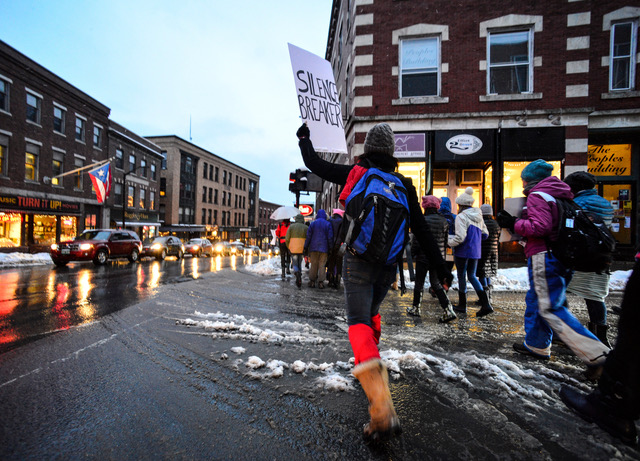
After reading the stories of other women who had been injured and violated, I was able to put down my shame and self-blame. Now I recognize that the teacher’s invasive adjustments are part of his larger pattern of aggression towards women, another way he asserts power over female bodies. I also see that my silence is inherited —I’ve been raised in rape culture, conditioned to doubt the truth of my sisters’ voices and the reality of my own experience, conditioned not to question a big man who stood on me. Now I take courage from our community standing together.
As my Facebook post blew up in December, YogaGirl (Rachel Brathen) published a piece on her influential blog that rocked the yoga world. Brathen collected over 300 #MeToo yoga experiences from her followers and chronicled the sexual abuses of dozens of teachers— often famous men who headline yoga festivals and lead international trainings. I felt sick as I scrolled through the anonymous accounts, violations ranging from breast-fondling and vagina-groping during class to forced oral sex and rape. None of the victims had spoken up before, afraid of being denigrated as liars or shunned by their yogic tribe. With no professional regulation in the yoga industry, there was no one to report to. No one could fire these predators.
Yoga is slowly waking from a century of patriarchal misconduct.
Senior Instructor Donna Farhi, an expert on yoga ethics, has spoken out on Facebook, decrying the sexual molestations of Pattabhi Jois and the cult-like complicity of his followers. Farhi has supported YogaGirl’s #MeToo project and called on victims to start naming names. The women’s whisper network is becoming a shout system. Even Yoga Journal wrote a Time’s Up article, asking “how can we finally put an end to sexual misconduct in the yoga community?” The piece included three #MeToo stories by prominent yoga teachers, advice on how to support victims, and guidelines from the Yoga Alliance on student-teacher power dynamics and ethical hands-on assists.
But what are the next steps? After the initial exhilaration of breaking silence — the clarity that comes from truth-telling — I feel the questions mounting.
How do we as a community protect our victims? How do we keep our yoga studios safe and hold violators accountable? Can there be a process of apology, reparation, and rehabilitation?
I don’t know if accountability is possible in a small town without creating further harm. I don’t even know what accountability looks like, given the yoga perpetrators who’ve walked away unscathed. Bikram remains at large, last seen teaching in Mexico. Amrit Desai, the disgraced guru from Kripalu, relocated to Florida and opened a self-named yoga institute, including a new multi-million-dollar healing arts complex. Desai leads international trainings and is billed as a “Living Yoga Master” in the ancient tradition. What tradition is that, I have to ask? One of deceit, manipulation, and abuses of power — a legacy of harm to female students.
At the root, we must stop more women from being hurt. After the year of the Silence Breakers, we must stop condoning spiritual predators in our midst, and let another principle of yoga guide our speech and action — satya, truthfulness, another word written on the studio wall. Our stories are powerful; our communal voice is fierce. It’s time to come in like the goddess Kali with her sword of truth, cutting through clouds of fear and confusion.



